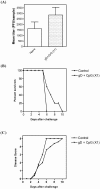Mucosal administration of CpG oligodeoxynucleotide elicits strong CC and CXC chemokine responses in the vagina and serves as a potent Th1-tilting adjuvant for recombinant gD2 protein vaccination against genital herpes
- PMID: 16699008
- PMCID: PMC1472142
- DOI: 10.1128/JVI.02013-05
Mucosal administration of CpG oligodeoxynucleotide elicits strong CC and CXC chemokine responses in the vagina and serves as a potent Th1-tilting adjuvant for recombinant gD2 protein vaccination against genital herpes
Abstract
Although sexually transmitted pathogens are capable of inducing pathogen-specific immune responses, vaginal administration of nonreplicating antigens elicits only weak, nondisseminating immune responses. The present study was undertaken to examine the potential of CpG-containing oligodeoxynucleotide (CpG ODN) for induction of chemokine responses in the genital tract mucosa and also as a vaginal adjuvant in combination with glycoprotein D of herpes simplex virus type 2 (HSV-2) for induction of antigen-specific immune responses. We found that a single intravaginal administration of CpG ODN in mice stimulates a rapid and potent response of CC chemokines macrophage inflammatory protein 1alpha (MIP-1alpha), MIP-1beta, and RANTES as well as of CXC chemokines MIP-2 and IP-10 in the vagina and/or the genital lymph nodes. Importantly, intravaginal vaccination with recombinant gD2 in combination with CpG ODN gave rise to a strong antigen-specific Th1-like immune response in the genital lymph nodes as well as the spleens of the vaccinated mice. Further, such an immunization scheme conferred both systemic and mucosal immunoglobulin G antibody responses as well as protection against an otherwise lethal vaginal challenge with HSV-2. These results illustrate the potential of CpG ODN for induction of potent chemokine responses in the genital tract and also as a vaginal adjuvant for generation of Th1-type mucosal and systemic immune responses towards a nonreplicating antigen derived from a sexually transmitted pathogen. These data have implications for the development of a mucosal vaccine against genital herpes and possibly other sexually transmitted diseases.
Figures






Similar articles
-
Intranasal immunization with CpG oligodeoxynucleotides as an adjuvant dramatically increases IgA and protection against herpes simplex virus-2 in the genital tract.J Immunol. 2001 Mar 1;166(5):3451-7. doi: 10.4049/jimmunol.166.5.3451. J Immunol. 2001. PMID: 11207303
-
CpG oligodeoxynucleotide augments HSV-2 glycoprotein D DNA vaccine efficacy to generate T helper 1 response and subsequent protection against primary genital herpes infection in mice.J Reprod Immunol. 2005 Dec;68(1-2):53-69. doi: 10.1016/j.jri.2005.06.010. Epub 2005 Oct 17. J Reprod Immunol. 2005. PMID: 16229896
-
Nasal and skin delivery of IC31(®)-adjuvanted recombinant HSV-2 gD protein confers protection against genital herpes.Vaccine. 2012 Jun 19;30(29):4361-8. doi: 10.1016/j.vaccine.2012.02.019. Vaccine. 2012. PMID: 22682292
-
The potential of immunostimulatory CpG DNA for inducing immunity against genital herpes: opportunities and challenges.J Clin Virol. 2004 Jul;30(3):207-10. doi: 10.1016/j.jcv.2004.03.001. J Clin Virol. 2004. PMID: 15135735 Review.
-
Improving immunogenicity and efficacy of vaccines for genital herpes containing herpes simplex virus glycoprotein D.Expert Rev Vaccines. 2014 Dec;13(12):1475-88. doi: 10.1586/14760584.2014.951336. Epub 2014 Aug 20. Expert Rev Vaccines. 2014. PMID: 25138572 Review.
Cited by
-
Mucosal herpes immunity and immunopathology to ocular and genital herpes simplex virus infections.Clin Dev Immunol. 2012;2012:149135. doi: 10.1155/2012/149135. Epub 2012 Dec 24. Clin Dev Immunol. 2012. PMID: 23320014 Free PMC article. Review.
-
A Dual-Modality Herpes Simplex Virus 2 Vaccine for Preventing Genital Herpes by Using Glycoprotein C and D Subunit Antigens To Induce Potent Antibody Responses and Adenovirus Vectors Containing Capsid and Tegument Proteins as T Cell Immunogens.J Virol. 2015 Aug;89(16):8497-509. doi: 10.1128/JVI.01089-15. Epub 2015 Jun 3. J Virol. 2015. PMID: 26041292 Free PMC article.
-
A genital tract peptide epitope vaccine targeting TLR-2 efficiently induces local and systemic CD8+ T cells and protects against herpes simplex virus type 2 challenge.Mucosal Immunol. 2009 Mar;2(2):129-143. doi: 10.1038/mi.2008.81. Epub 2008 Dec 24. Mucosal Immunol. 2009. PMID: 19129756 Free PMC article.
-
Immunization with a dominant-negative recombinant Herpes Simplex Virus (HSV) type 1 protects against HSV-2 genital disease in guinea pigs.BMC Microbiol. 2010 Jun 3;10:163. doi: 10.1186/1471-2180-10-163. BMC Microbiol. 2010. PMID: 20525279 Free PMC article.
-
Blocking herpes simplex virus 2 glycoprotein E immune evasion as an approach to enhance efficacy of a trivalent subunit antigen vaccine for genital herpes.J Virol. 2014 Aug;88(15):8421-32. doi: 10.1128/JVI.01130-14. Epub 2014 May 14. J Virol. 2014. PMID: 24829358 Free PMC article.
References
-
- Bonecchi, R., G. Bianchi, P. P. Bordignon, D. D'Ambrosio, R. Lang, A.Borsatti, S. Sozzani, P. Allavena, P. A. Gray, A. Mantovani, and F. Sinigaglia. 1998. Differential expression of chemokine receptors and chemotactic responsiveness of type 1 T helper cells (Th1s) and Th2s. J. Exp. Med. 187:129-134. - PMC - PubMed
-
- Cocchi, F., A. L. DeVico, A. Garzino-Demo, S. K. Arya, R. C. Gallo, and P. Lusso. 1995. Identification of RANTES, MIP-1 alpha, and MIP-1 beta as the major HIV-suppressive factors produced by CD8+ T cells. Science 270:1811-1815. - PubMed
-
- Farber, J. M. 1997. Mig and IP-10: CXC chemokines that target lymphocytes. J. Leukoc. Biol. 61:246-257. - PubMed
-
- Gangur, V., F. E. Simons, and K. T. Hayglass. 1998. Human IP-10 selectively promotes dominance of polyclonally activated and environmental antigen-driven IFN-gamma over IL-4 responses. FASEB J. 12:705-713. - PubMed
Publication types
MeSH terms
Substances
Grants and funding
LinkOut - more resources
Full Text Sources
Medical

